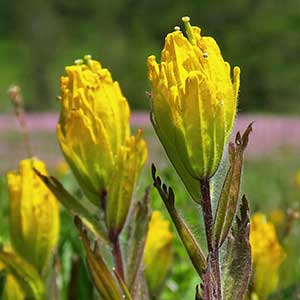Castilleja levisecta
Castilleja sessiliflora
golden Indian paintbrush, golden paintbrush
downy paintedcup, Great Plains Indian paintbrush
few to many, erect, ± decumbent or creeping at base, unbranched, sometimes branched, hairs spreading, medium length and long, soft, mixed with short stipitate-glandular ones.
few to many, ascending to erect, often decumbent at base, unbranched, sometimes branched, hairs spreading, sometimes matted, short to medium length, ± soft, eglandular, often with a layer of minute-glandular hairs, sometimes woolly.
green to purple or brown-tinged, linear-lanceolate proximally, oblong-ovate or -obovate distally, 0.8–5.2 cm, not fleshy, margins plane, distalmost sometimes ± wavy, involute, 3–7(–11)-lobed, apex obtuse;
lobes erect to ascending, linear to linear-spatulate, very short, toothlike, usually arising from distal 1/3 of blade, apex rounded.
green to purple, or grayish with dust and hairs, linear to narrowly lanceolate, (1–)2–5(–6) cm, not fleshy, margins plane, involute, (0–)3–5-lobed, apex acuminate to acute;
lobes divergent, spreading, linear, apex acute.
2.5–25 × 1–4 cm;
bracts bright yellow throughout, or proximally greenish, distally bright yellow, sometimes deep yellow-orange, especially with age, oblong, elliptic, or obtuse to ovate, (0–)5–9(–13)-lobed, sometimes wavy-margined;
lobes erect to ascending, oblong, short to medium length, arising above mid length, central lobe apex rounded, lateral ones rounded to acute.
3–18 × 2.5–6.5 cm;
bracts green to purplish throughout, sometimes reddish brown, pink, or lavender throughout, or distally white or pale yellow, sometimes distally dull pink, pink, salmon, orangish, pale pink-orange, buff, or cream, lanceolate, similar to distal leaves, 3(–5)-lobed;
lobes spreading, linear-lanceolate, long, arising at or below mid length, apex acute to acuminate, sometimes obtuse.
straight or slightly curved, 17–28 mm;
tube 12–15 mm;
beak exserted, adaxially green or greenish yellow, 6–8 mm;
abaxial lip yellow or greenish, reduced, not inflated, 2–3 mm, 25–33(–50)% as long as beak;
teeth ascending to erect, yellow, 0.5–1.5 mm.
strongly curved distally, 35–55 mm;
tube 24–45 mm;
abaxial lip, beak, and distal portion of tube exserted;
beak adaxially green, yellow, pinkish, purplish, or whitish, 9–15 mm;
abaxial lip green, pale green, or purple, protruding, shelflike, 4–8 mm, 50–70% as long as beak;
teeth spreading, white, pale yellow, pink, or purple, 3–4 mm.
distally yellow, 13–22 mm;
abaxial and adaxial clefts 4–9.5 mm, 30–40% of calyx length, deeper than laterals, lateral 2.5–4.5 mm, ca. 25% of calyx length;
lobes linear to narrowly oblong or narrowly lanceolate, apex obtuse, sometimes rounded to acute.
colored as bracts, sometimes proximally white, 20–40 mm;
abaxial and adaxial clefts 12–20 mm, 40–60% of calyx length, deeper than laterals, lateral 5–15 mm, 10–25% of calyx length;
lobes linear, apex acute to acuminate.
= 24.
= 24.
Castilleja levisecta
Castilleja sessiliflora
Castilleja levisecta is listed as threatened in the United States and endangered in Canada, where it is extremely rare. Most of its grassland habitat has been altered by development in the Puget Trough, and there are historical stations in the metro areas of what are now Victoria, Portland, and Seattle. For several decades, C. levisecta was considered extirpated from Oregon. However, recent reintroduction programs in Oregon and Washington have been very successful at reestablishing this species at several sites in the Willamette Valley. The bright yellow inflorescences often gradually age to a golden yellow color, unique in the genus.
Castilleja levisecta is in the Center for Plant Conservation’s National Collection of Endangered Plants.
(Discussion copyrighted by Flora of North America; reprinted with permission.)
Castilleja sessiliflora ranges across the Great Plains from southern Canada to northern Mexico, where it is apparently rare. In Texas and northern Mexico, its range overlaps with the similar C. mexicana. Most populations of C. sessiliflora, especially north of Texas, have white to pale yellow inflorescences; in southwestern Texas they are more variable in color, with pink-purple plants often predominating locally. Those plants with pink-purple inflorescences were named forma purpurina by F. W. Pennell. In the limestone deserts of southern New Mexico and southeastern Arizona, the inflorescences are often a pale pink-orange, but these are intermingled with more typical greenish white plants. Occasional hybrids between C. angustifolia var. dubia and C. sessiliflora are known from northeastern Wyoming.
(Discussion copyrighted by Flora of North America; reprinted with permission.)


